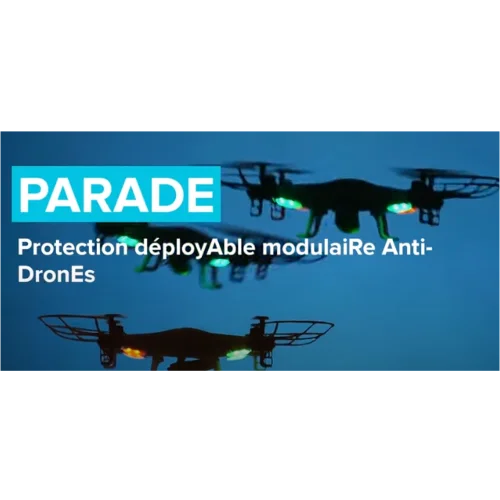By Pierre Tran
Paris – A parliamentary report on counter-drone systems is due to appear this month, pointing up shortfalls in the military Parade program, critical for the 2024 Olympic Games in the French capital, senator Cédric Pérrin said Dec. 14, 2023.
“I take the view that our anti-drone campaign, particularly Parade, does not meet the requirements – we have some real holes in the racket,” he told the Association of Defense Journalists, a press club.
Senators Loic Hervé, Rashid Temal and Philippe Paul are working on the report, looking into the French capability for counter-unmanned aerial vehicles (C-UAV), particularly the Parade program in the light of the Olympic Games, said Perrin, chair of the senate armed forces, defense and foreign affairs committee.
The report will be published toward the end of January, he said, which was late, but with recommendations and just enough time for any alternative solutions.
The French capital will be host for the Olympic Games, July 26-August 11, and the authorities are determined to provide security for the sports fans from all over the world, with at least 600,000 spectators expected to attend the opening ceremony on the six-kilometer route along the banks of the Seine river.
Perrin, who called for the use of French rather than foreign kit, said he has been concerned about late delivery of Parade, which failed to be deployed at the Paris air show in the summer and the rugby world cup tournament in the autumn.
Concerns over Parade meeting technical requirements and its program delay led to the need to “sound the alarm,” he said.
Parade to the Olympics
“There is no doubt Parade will be operational and deployed” for the Olympic Games, said Tony Valin, director of the counter-drone unit at CS group, a joint prime contractor on the program.
The first six-strong batch of Parade has been delivered to the Direction Générale de l’Armement (DGA) procurement office, he said, and certification was underway, with qualification due “by the end of the year.”
The program delay was due to difficulties in the supply chain, with late delivery of electronic components from subcontractors and the Covid lockdowns, he said. The program was large and the timing “exceptionally short.”
The DGA awarded the Parade contract in 2022 to CS group and Thales, which led a consortium of small and medium French companies including CerbAir, Exavision, and MC2 Technologies, and a Dutch 3-D radar supplier, Robin. The system draws on artificial intelligence, Valin said.
Parade will be deployed at the games, along with a similar, lighter CS counter-drone system, dubbed Radiant. The police force has ordered two Radiant systems for the world-class sports event.
Parade had European content, with some 90 percent French, while U.K. suppliers were excluded due to Brexit, Valin said. The program was restricted to “European” candidates, ruling out British companies, much as firms from the U.S., Israel and other nations outside the European Union were disallowed. The maximum value of the project was €350 million for a prospective order for 50 systems.
There is an order for a first batch of six Parade, with options for a further nine, bringing that to 15 in the 2024-2030 military budget law.
The total program value of €350 million was for 11 years, with the initial order worth €33 million, Thales said in statement April 29 2022.
“The first Parade systems will be delivered to the DGA in less than a year from launch of the program,” the company said.
Meanwhile, Perrin said there have been several counter-drone exercises over the year, which have not shown satisfactory performance, and the system was only “working partially.”
The senator has asked questions in parliament and has latterly talked to the press, in a bid to alert the authorities.
Thales and CS had invited Perrin to see the Parade deployed– but not operated – in the Stade de France stadium, in the northern suburbs of the capital, but conflict of planning meant the senator had not been able to see the system, Valin said.
Parade is designed for deployment, intended to detect, identify, and neutralize mini and micro drones in a safe way. Protection of large crowds at public events and infrastructure are key parts of the mission.
The detection and classification elements of Parade consist of a radar with an “instrumented range” of five km and 360° coverage, a system for picking up radio frequencies directing drones, and an electro-optical camera for visual identification.
The aim is to detect and distinguish between a bird or a drone, ranging between 100gm-25kg, and send a jamming signal, including GPS, to divert or force the UAV to land.
At the heart of the system is the CS group’s Boreade command and control system, which works for the Parade and Radiant counter-UAV systems.
The delay on Parade has raised questions in parliament.
“We have a three-month delay due to problems of supply and industrial qualification of subsystems,” Emmanuel Chiva, the DGA head, told parliamentarians in early May, in response to Perrin’s question, FOB website reported June 9.
France has seen the number of drones rise to 2.5 million in 2021 from 400,000 in 2017, Agence France-Presse reported.
Elsewhere in the counter-UAV market, DroneShield, an Australian-U.S. company, said in a Dec. 19 statement it had launched DroneSentry-C2 Tactical (DroneSentry-C2T), a rugged, tablet-based version of its command and control system for counter-UAV, DroneSentry-C2.
If proof were needed that the Paris Olympic Games is drawing wider interest, there is the latest novel from British writer Stephen Clarke – Merde at the Paris Olympics – a humorous tale of a French group seeking to get the quintessential French sport pétanque – bowling – on the list of Olympic games.


